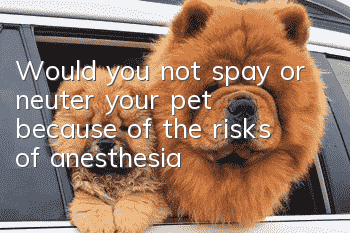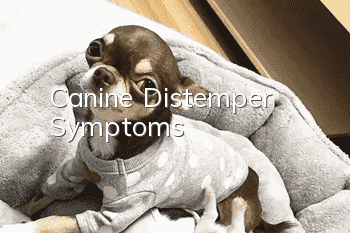Would you not spay or neuter your pet because of the risks of anesthesia?

Many parents want to take their babies to the hospital for sterilization surgery for the health of their furry babies. However, once they hear the doctor tell them that surgical anesthesia is risky and can cause death in severe cases, they start to wonder whether to perform surgery on their little ones? There are also some babies. Emergency surgery is needed because of illness, such as eating foreign objects, urinary system stones, or pyometra due to not being sterilized when young, and other diseases that can only be cured by surgery, but because mommies are obsessed with the risks of anesthesia , which missed the opportunity for surgery and led to the tragedy of the furry child’s death. Let’s hear what the doctor from Barbie Hall has to say~
Lecturer: Song Licong
Master of Clinical Veterinary Medicine, Beijing Agricultural College
What is anesthesia
Generally speaking, anesthesia is the temporary disappearance of intuition, which allows the animal to perform surgery in a quiet state, so that the animal does not feel potentially severe pain during the operation. The ideal anesthesia state should be unconscious, painless, no memory, and stable physical signs. This state should satisfy the anesthesiologist, the surgeon, and the animal, rather than just giving an injection and sleeping through the surgery as some parents of furry children think. It's over. Injection anesthesia like this imagined by parents is very dangerous, and the risks of anesthesia are also very high. When the animal is in danger during the operation, the anesthesia cannot be stopped immediately to wake the animal. In order to avoid the risks of injection anesthesia, Dr. Dong Yi of Barbie Hall took the lead in introducing respiratory anesthesia to China. Respiratory anesthesia can stop the anesthesia immediately when the animal is in danger, increase the oxygen flow, and wake up quickly, causing little damage to the body. It will not take several hours to metabolize the anesthetic in the body like injection anesthesia, which greatly increases the burden on the liver and kidneys.
What are the risks of anesthesia
1. Depending on the age, breed, and body condition of the animal, the anesthesia complications faced are also different: cardiac arrest, bradycardia, arrhythmia, hypoventilation, hypoxemia, hypotension, and hypertension.
2. The incidence of cardiac and respiratory arrest related to general anesthesia is only in dogs and only in cats. When cardiac arrest occurs, performing CPR in a shorter period of time can improve the animal's survival rate. If cardiac and respiratory arrest occurs, the volatile irrigation should be closed immediately and the oxygen flow should be increased. There is hypoxia before the animal is arrested. This is not a problem for anesthetized cases with tracheal intubation and ventilation. This reflects the respiratory Advantages of anesthesia. The order of rescue in case of cardiac and respiratory arrest should be ABCD (open airway, artificial respiration, artificial circulation, drugs).
3. There are many causes of bradycardia, such as increased intracranial pressure (Cushing's reflex), brachycephaly, athlete's quality, hyperkalemia and hypoxemia, and the more common cause is hypothermia. Bradycardia may be a precursor to cardiorespiratory arrest, especially in cats.
4.HeartTachycardia is caused by the sustained excitation of ectopic nodes located in myocardial fiber cells or the Purkinje conduction system that can cause VF. Hypoxia, electrolyte changes, trauma, sepsis, pancreatitis, gastric dilatation volvulus, ischemia, severe pain, primary heart disease, and other syndromes may cause tachycardia. Lidocaine is a drug needed to treat tachycardia.
Although there are many complications of anesthesia, professional anesthesiologists can provide reasonable induction anesthesia plans by assessing the animal's preoperative physical condition. The advantage of induction anesthesia (balanced anesthesia/compound anesthesia) is that it can reduce the dosage of anesthetics, reduce side effects, and increase Synergy. During the operation, the anesthesiologist can fully judge the animal's condition with the help of the ECG monitor, discover potential anesthesia risks at the first time, and protect the animal's life safety!
What are the consequences of anesthesia risks
❥ Extended recovery time
The recovery time depends on the animal's own pathophysiological conditions, anesthesia medication, management, type of surgery, surgery time and many other factors. Overdose of drugs, wrong timing of administration, respiratory failure, abnormal body temperature, metabolic disorders such as hypoglycemia, severe hyperglycemia, electrolyte imbalance, acidosis, etc. can all cause delayed recovery. For inhalational anesthesia, the speed of emergence is directly related to the degree of alveolar ventilation, so hypoventilation is a common cause of delayed emergence.
❥ Damage to liver, kidney and lung function
General anesthesia causes cardiac depression, vasoconstriction, and reduced renal blood flow. During positive pressure ventilation, it also affects the amount of blood returned to the heart, ultimately leading to reduced urine output and affecting renal function. The liver is extremely sensitive to any hypotension and hypoxia during surgery. 20%-30% of the hepatic arteries bear 60%-80% of the liver's supply. The damage to liver function caused by hypoxia during surgery has nothing to do with the anesthesia technique. Prolonged hypotension can lead to ischemic hepatitis.
❥ Acute heart failure
Animals with perioperative acute heart failure are often complicated by severe cardiovascular and respiratory system diseases.
❥ Death from anesthesia
Inaccurate assessment of animal body condition, improper selection of anesthetic drugs, and improper anesthesia methods will increase the risk of anesthesia. Inadequate detection of animals during and after surgery leads to cardiac arrest or brain death in animals due to hypoxemia, which is a common cause of death under anesthesia in animals.
How to avoid anesthesia risks as much as possible
In addition to the animal's own condition, the anesthesiologist, anesthesia equipment, and operator are allFactors that directly affect anesthesia risk.
In addition, the anesthesia plan is a top priority, including: anesthesia method, duration of surgery or operation, body position, selection of pre-anesthetic drugs, anticipated potential complications, emergency handling, pain management, and airway management. , fluid management, body temperature management, perioperative monitoring, etc. To achieve this, a team with tacit cooperation, rich experience, and animal life as the first element is required to work together (Click to learn more about the expert team of Barbietang Animal Hospital). To sum up, I would like to warn all parents of furry children to choose regular and professional hospitals for medical treatment for the health of their babies!
Diagnosis and treatment advantages of Barbietang Animal Hospital
Find the right hospital and the right expert to increase the security of pet sterilization!
- What to do if a puppy bites a chicken
- What are the treatments for Shiba Inu vomiting?
- How old can a dog take a bath?
- Be alert! List of dog food taboos!
- Canine Impetigo Causes | Diagnosis | Prevention and Treatment Methods
- How much does a black Labrador retriever cost? Black Labrador retriever price!
- Things to note when raising a Pomeranian
- Several causes of dog hair loss and solutions!
- What should I do if my dog vomits and won’t eat?
- Why does a dog vomit out dog food but it is still intact?



